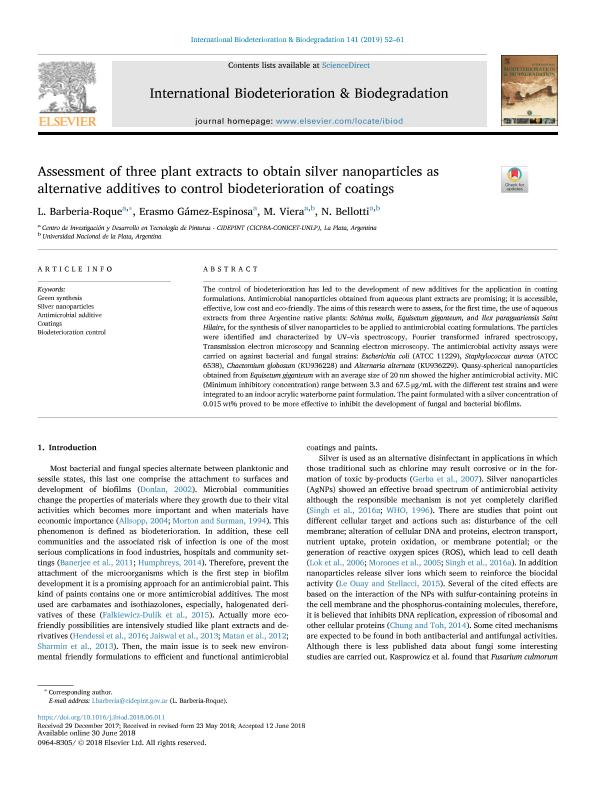Artículo
Assessment of three plant extracts to obtain silver nanoparticles as alternative additives to control biodeterioration of coatings
Fecha de publicación:
06/2018
Editorial:
Elsevier
Revista:
International Biodeterioration and Biodegradation
ISSN:
0964-8305
Idioma:
Inglés
Tipo de recurso:
Artículo publicado
Clasificación temática:
Resumen
The control of biodeterioration has led to the development of new additives for the application in coating formulations. Antimicrobial nanoparticles obtained from aqueous plant extracts are promising; it is accessible, effective, low cost and eco-friendly. The aims of this research were to assess, for the first time, the use of aqueous extracts from three Argentine native plants: Schinus molle, Equisetum giganteum, and Ilex paraguariensis Saint Hilaire, for the synthesis of silver nanoparticles to be applied to antimicrobial coating formulations. The particles were identified and characterized by UV?vis spectroscopy, Fourier transformed infrared spectroscopy, Transmission electron microscopy and Scanning electron microscopy. The antimicrobial activity assays were carried on against bacterial and fungal strains: Escherichia coli (ATCC 11229), Staphylococcus aureus (ATCC 6538), Chaetomium globosum (KU936228)and Alternaria alternata (KU936229). Quasy-spherical nanoparticles obtained from Equisetum giganteum with an average size of 20 nm showed the higher antimicrobial activity. MIC (Minimum inhibitory concentration)range between 3.3 and 67.5 μg/mL with the different test strains and were integrated to an indoor acrylic waterborne paint formulation. The paint formulated with a silver concentration of 0.015 wt% proved to be more effective to inhibit the development of fungal and bacterial biofilms.
Archivos asociados
Licencia
Identificadores
Colecciones
Articulos(CIDEPINT)
Articulos de CENTRO DE INV EN TECNOLOGIA DE PINTURAS (I)
Articulos de CENTRO DE INV EN TECNOLOGIA DE PINTURAS (I)
Citación
Barberia Roque, Leyanet; Gámez Espinosa, Erasmo Junior; Viera, Marisa Rosana; Bellotti, Natalia; Assessment of three plant extracts to obtain silver nanoparticles as alternative additives to control biodeterioration of coatings; Elsevier; International Biodeterioration and Biodegradation; 141; 6-2018; 52-61
Compartir
Altmétricas




